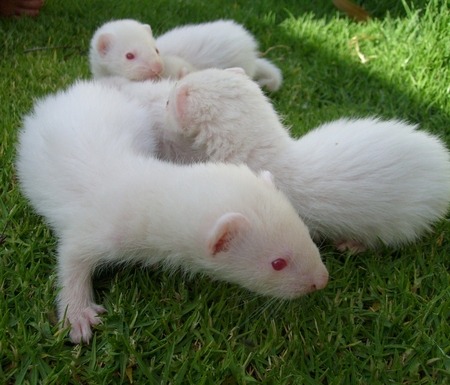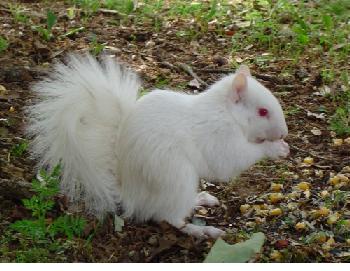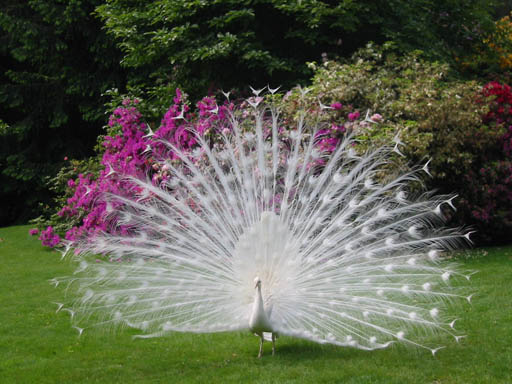|
|
|---|
Saturday, August 7, 2010
These cute, furry dogs are another one of the breeds that the AKC decided to recognize this year. I think they look way friendlier than cane corsos, so I'd much rather have one as my buddy than a cane corso.
Icelandic sheepdogs come from Iceland, which you maybe already figured out by now. They are the only kind of dog to get their start in Iceland. And the way the breed got started there was that when some people called Vikings first went to Iceland to live, in the years between 874 and 930 A.D., they took dogs there with them. And we know that dogs like this had already been around for a long time in Scandinavia because their bones have been found in really, really old graves, like from 8000 B.C.
So the people who lived in Iceland used their dogs to help with rounding up sheep and guarding lambs from big, mean birds that wanted to swoop down and grab a little yummy mutton for their dinner. Icelandic sheepdogs were also good at finding sheep who were lost and at rounding up other types of livestock. They don't really do herding in the same way a border collie does, like by nipping heels. Mostly they bark at animals until the animals move. And barking is also how Icelandic sheepdogs scare off hawks and other birds of prey. So they tend to be dogs who bark a lot at all kinds of things.
Anyway, the Icelandic sheepdogs lived happily in Iceland for many years until the late 1800s, and then a bunch of them got sick from distemper and tapeworms, and they died. So after that, there weren't many dogs left in Iceland, especially since a law got passed to keep from bringing more dogs into the country for a while. But eventually the breed recovered. Then it almost died out again in the 20th century. But in 1969, a group called the Icelandic Dog Breeder Association was founded to help save the Icelandic sheepdog, and they did a good job of this.
Icelandic sheepdogs are not hunters. They are not really aggressive at all. They love people, and they like to be with their people all the time, so they get bad separation anxiety if they are in a situation like a kennel. Also they don't like it if you are mean to them or use harsh training methods with them. They are good with children, and they greet strangers in a very friendly, happy way, without even doing a background check or anything!
These dogs are smart, and they really like to please their humans, so they are easy to train. They are playful and curious and lively and affectionate. Also they get along well with other dogs and cats. They are still used as working dogs in Iceland, but they can also be good at agility, tracking, and as therapy dogs.
The main bad things about Icelandic sheepdogs are that they might bark a lot, chase cars, have separation anxiety, and they are good at jumping fences or digging under them.
Icelandic sheepdogs can be a lot of different colors. Also they can have a long coat or a short coat. The boy dogs are about 18" tall, and the girls are 16-1/2" tall. They have prick ears and kind of a foxlike face and double dewclaws on their back feet. They have curly tails, sort of like basenjis do, but with a whole bunch more hair!
Oh, and they like to play in water or run around in snow, both of which are kind of dumb, if you want my opinion. But I guess if you live in Iceland, you have to like snow and ice. And maybe volcanoes, too!
Icelandic sheepdogs come from Iceland, which you maybe already figured out by now. They are the only kind of dog to get their start in Iceland. And the way the breed got started there was that when some people called Vikings first went to Iceland to live, in the years between 874 and 930 A.D., they took dogs there with them. And we know that dogs like this had already been around for a long time in Scandinavia because their bones have been found in really, really old graves, like from 8000 B.C.
So the people who lived in Iceland used their dogs to help with rounding up sheep and guarding lambs from big, mean birds that wanted to swoop down and grab a little yummy mutton for their dinner. Icelandic sheepdogs were also good at finding sheep who were lost and at rounding up other types of livestock. They don't really do herding in the same way a border collie does, like by nipping heels. Mostly they bark at animals until the animals move. And barking is also how Icelandic sheepdogs scare off hawks and other birds of prey. So they tend to be dogs who bark a lot at all kinds of things.
Anyway, the Icelandic sheepdogs lived happily in Iceland for many years until the late 1800s, and then a bunch of them got sick from distemper and tapeworms, and they died. So after that, there weren't many dogs left in Iceland, especially since a law got passed to keep from bringing more dogs into the country for a while. But eventually the breed recovered. Then it almost died out again in the 20th century. But in 1969, a group called the Icelandic Dog Breeder Association was founded to help save the Icelandic sheepdog, and they did a good job of this.
Icelandic sheepdogs are not hunters. They are not really aggressive at all. They love people, and they like to be with their people all the time, so they get bad separation anxiety if they are in a situation like a kennel. Also they don't like it if you are mean to them or use harsh training methods with them. They are good with children, and they greet strangers in a very friendly, happy way, without even doing a background check or anything!
These dogs are smart, and they really like to please their humans, so they are easy to train. They are playful and curious and lively and affectionate. Also they get along well with other dogs and cats. They are still used as working dogs in Iceland, but they can also be good at agility, tracking, and as therapy dogs.
The main bad things about Icelandic sheepdogs are that they might bark a lot, chase cars, have separation anxiety, and they are good at jumping fences or digging under them.
Icelandic sheepdogs can be a lot of different colors. Also they can have a long coat or a short coat. The boy dogs are about 18" tall, and the girls are 16-1/2" tall. They have prick ears and kind of a foxlike face and double dewclaws on their back feet. They have curly tails, sort of like basenjis do, but with a whole bunch more hair!
Oh, and they like to play in water or run around in snow, both of which are kind of dumb, if you want my opinion. But I guess if you live in Iceland, you have to like snow and ice. And maybe volcanoes, too!
0 Comments:
Subscribe to:
Post Comments (Atom)






















